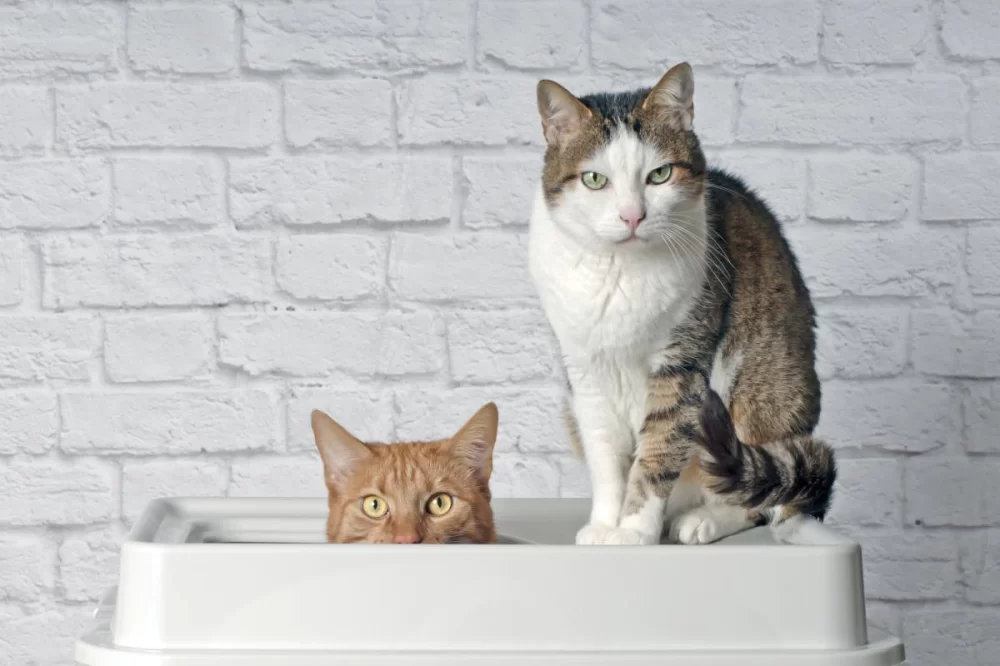- Why Choosing the Right Litter for Multiple Cats Matters
- Key Features of the Best Cat Litter for Multiple Cats
- Common Challenges and Solutions in Multi-Cat Households
- Real-Life Example from Hidden Brook Veterinary
- How to Maintain Cat Litter When You Have Multiple Cats
1. Why Choosing the Right Litter for Multiple Cats Matters
When you have more than one feline friend, the choice of cat litter becomes more critical than ever. Multiple cats naturally mean more frequent litter box use, which can quickly lead to odor buildup, clumping issues, and litter tracking. The “best cat litter for multiple cats” is designed to tackle these problems head-on, keeping both your home environment fresh and your cats comfortable.
Beyond convenience, the right litter supports your cats’ health and hygiene. For instance, a litter that controls odor well prevents cats from developing aversions to their litter box, which can otherwise lead to inappropriate elimination behaviors. In a multi-cat household, avoiding such behavioral problems is essential for peaceful coexistence.
Understanding the stakes
Imagine a household with three or more cats sharing just one or two litter boxes. Without an effective litter, unpleasant smells can dominate the living space, causing stress for both pets and their owners. This is why investing in a high-quality litter tailored for multiple cats is not just about cleanliness but also about maintaining harmony and health in your home.
2. Key Features of the Best Cat Litter for Multiple Cats
Choosing the ideal cat litter for multiple cats means looking for several important qualities. The best products excel in odor control, clumping ability, dust reduction, and ease of maintenance. Let's break down each feature:
Odor Control
Odor control is arguably the top priority in multi-cat litter. High-quality litters use advanced formulas or natural additives like activated charcoal or baking soda to neutralize smells. This ensures the litter box area stays fresh even with heavy use.
Strong Clumping
Efficient clumping helps to isolate urine and feces quickly, making scooping easier and preventing the entire litter bed from becoming contaminated. This is especially important in multi-cat homes, where multiple deposits accumulate rapidly.
Low Dust and Tracking
Dust can cause respiratory issues for both cats and humans, and litter tracking spreads mess throughout the house. The best multi-cat litters minimize dust production and have heavier granules or textured surfaces that reduce tracking.
Absorbency and Longevity
Because multiple cats use the box, the litter needs to absorb liquids well and last longer without frequent complete changes. This not only saves time and money but also reduces disruption to your cats' routine.
3. Common Challenges and Solutions in Multi-Cat Households
Having several cats brings unique litter box challenges beyond just choosing the right litter. Here are some common issues and practical solutions:
Challenge 1: Territorial Behavior
Some cats may guard their litter box or refuse to share. Providing multiple litter boxes, ideally one per cat plus one extra, helps ease tension. Using the best cat litter for multiple cats that neutralizes odor quickly makes each box more appealing.
Challenge 2: Frequent Cleaning Needs
Litter boxes in multi-cat homes require more frequent scooping to prevent odors and messes. Consider litters with superior clumping and odor control to extend the time between full changes. Automated litter boxes can also be a helpful investment.
Challenge 3: Litter Box Aversion
If a litter box smells bad or is dirty, cats may avoid it, leading to accidents. Choosing a litter with excellent odor control and cleaning regularly is key to preventing this. Also, selecting litter with a scent profile that your cats tolerate well is important, as some cats are sensitive to strong fragrances.
4. Real-Life Example from Hidden Brook Veterinary
At Hidden Brook Veterinary, many multi-cat households have sought advice about litter box problems. One memorable case involved a family with four cats experiencing constant odor issues and one cat refusing to use the litter box.
After switching to a premium clumping litter specifically designed for multiple cats, incorporating baking soda and activated charcoal, the odor problem significantly diminished. The veterinarian also recommended increasing the number of litter boxes and establishing a strict cleaning schedule.
The result? All cats returned to consistent litter box use, and the home environment became much more pleasant. This case highlights how choosing the right litter combined with good maintenance practices can solve multi-cat litter box challenges.
5. How to Maintain Cat Litter When You Have Multiple Cats
Even the best cat litter for multiple cats requires proper maintenance to work effectively. Here are advanced tips to keep your litter boxes in top shape:
Routine Scooping
For multiple cats, scooping at least twice daily is recommended. This prevents odors and encourages all cats to use the box.
Regular Litter Replacement
Even the best clumping litter should be fully replaced weekly or biweekly, depending on usage. This maintains freshness and prevents bacterial buildup.
Litter Box Hygiene
Thoroughly clean the litter boxes with mild soap and water during litter changes. Avoid strong-smelling cleaners that may deter cats.
Box Placement
Place boxes in quiet, accessible areas to reduce stress for cats. Avoid placing boxes next to noisy appliances or heavy foot traffic zones.
For those seeking professional guidance or the best products tailored to multi-cat households, Hidden Brook Veterinary offers expert advice and a curated selection of top-performing litters and related supplies.












